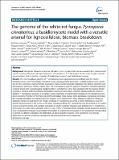Por favor, use este identificador para citar o enlazar a este item:
http://hdl.handle.net/10261/110031COMPARTIR / EXPORTAR:
 SHARE SHARE
 CORE
BASE CORE
BASE
|
|
| Visualizar otros formatos: MARC | Dublin Core | RDF | ORE | MODS | METS | DIDL | DATACITE | |

| Título: | The genome of the white-rot fungus Pycnoporus cinnabarinus: a basidiomycete model with a versatile arsenal for lignocellulosic biomass breakdown |
Autor: | Levasseur, Anthony; Ruiz-Dueñas, F. J. CSIC ORCID ; Martínez, Ángel T. CSIC ORCID ; Record, Éric | Palabras clave: | Pycnoporus cinnabarinus Genome annotation CAZy Auxiliary activities Oxidoreductase White-rot fungi Lignocellulose |
Fecha de publicación: | 18-jun-2014 | Editor: | BioMed Central | Citación: | BMC Genomics 15: 486 (2014) | Resumen: | [Background]
Saprophytic filamentous fungi are ubiquitous micro-organisms that play an essential role in photosynthetic carbon recycling. The wood-decayer Pycnoporus cinnabarinus is a model fungus for the study of plant cell wall decomposition and is used for a number of applications in green and white biotechnology. [Results] The 33.6 megabase genome of P. cinnabarinus was sequenced and assembled, and the 10,442 predicted genes were functionally annotated using a phylogenomic procedure. In-depth analyses were carried out for the numerous enzyme families involved in lignocellulosic biomass breakdown, for protein secretion and glycosylation pathways, and for mating type. The P. cinnabarinus genome sequence revealed a consistent repertoire of genes shared with wood-decaying basidiomycetes. P. cinnabarinus is thus fully equipped with the classical families involved in cellulose and hemicellulose degradation, whereas its pectinolytic repertoire appears relatively limited. In addition, P. cinnabarinus possesses a complete versatile enzymatic arsenal for lignin breakdown. We identified several genes encoding members of the three ligninolytic peroxidase types, namely lignin peroxidase, manganese peroxidase and versatile peroxidase. Comparative genome analyses were performed in fungi displaying different nutritional strategies (white-rot and brown-rot modes of decay). P. cinnabarinus presents a typical distribution of all the specific families found in the white-rot life style. Growth profiling of P. cinnabarinus was performed on 35 carbon sources including simple and complex substrates to study substrate utilization and preferences. P. cinnabarinus grew faster on crude plant substrates than on pure, mono- or polysaccharide substrates. Finally, proteomic analyses were conducted from liquid and solid-state fermentation to analyze the composition of the secretomes corresponding to growth on different substrates. The distribution of lignocellulolytic enzymes in the secretomes was strongly dependent on growth conditions, especially for lytic polysaccharide mono-oxygenases. [Conclusions] With its available genome sequence, P. cinnabarinus is now an outstanding model system for the study of the enzyme machinery involved in the degradation or transformation of lignocellulosic biomass. |
Descripción: | 24 p.-8 fig.-4 tab.-- Levasseur, Anthony et al. | Versión del editor: | http://dx.doi.org/10.1186/1471-2164-15-486 | URI: | http://hdl.handle.net/10261/110031 | DOI: | 10.1186/1471-2164-15-486 | ISSN: | 1471-2164 | E-ISSN: | 1471-2164 |
| Aparece en las colecciones: | (CIB) Artículos |
Ficheros en este ítem:
| Fichero | Descripción | Tamaño | Formato | |
|---|---|---|---|---|
| BMC Genomics 2014, 15 (486) F.J. Ruiz Dueñas.pdf | 2 MB | Adobe PDF |  Visualizar/Abrir |
CORE Recommender
PubMed Central
Citations
40
checked on 19-abr-2024
SCOPUSTM
Citations
82
checked on 28-abr-2024
WEB OF SCIENCETM
Citations
69
checked on 23-feb-2024
Page view(s)
291
checked on 01-may-2024
Download(s)
247
checked on 01-may-2024

